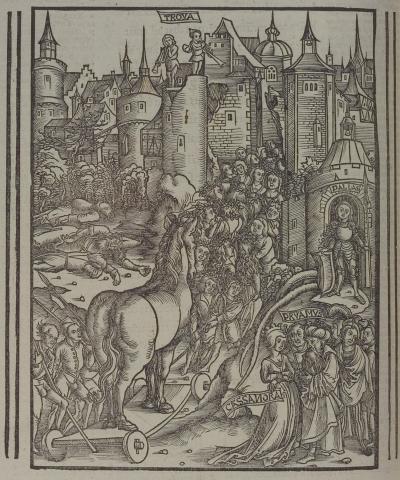Annotations
In the middle left, Laocoon lies dead, after being killed by serpents (199-224). The long tails of the two serpents can be seen sticking out from behind the shield of the armored statue of Pallas Athena (225-7), to the right of the wooden horse. The Trojans, taking these events as a sign that Laocoon angered the goddess by attempting to harm the horse (228-31), bring the horse into the city, to the temple of Pallas (234-8). To the lower left, men stand near the back wheels, guiding it, while in front of the horse, youths pull it forward with ropes (235-9). Around the entrance to the city, Trojans wear garlands on their heads in celebration. In the lower right-hand corner, Cassandra, cursed so that her prophecies are never believed, attempts in vain to warn Priam that the horse is dangerous (246-7). (Katy Purington)
Woodcut illustration from the “Strasbourg Vergil,” edited by Sebastian Brant: Publii Virgilii Maronis Opera cum quinque vulgatis commentariis expolitissimisque figuris atque imaginibus nuper per Sebastianum Brant superadditis (Strasbourg: Johannis Grieninger, 1502), fol. 164v, executed by an anonymous engraver under the direction of Brant.


Sebastian Brant (1458–1521) was a humanist scholar of many competencies. Trained in classics and law at the University of Basel, Brant later lectured in jurisprudence there and practiced law in his native city of Strasbourg. While his satirical poem Das Narrenschiff won him considerable standing as a writer, his role in the transmission of Virgil to the Renaissance was at least as important. In 1502 he and Strasbourg printer Johannes Grüninger produced a major edition of Virgil’s works, along with Donatus’ Life and the commentaries of Servius, Landino, and Calderini, with more than two hundred woodcut illustrations. (Annabel Patterson)